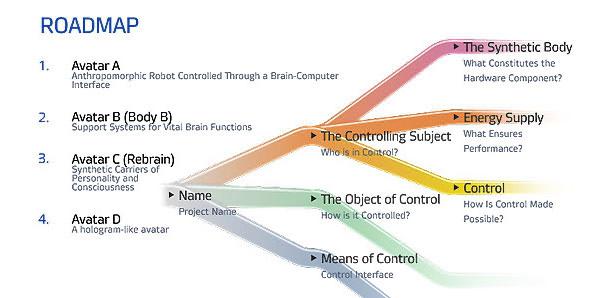Transhumanism: The Rise of the Avatars
 For those unfamiliar with the full goals of The Singularity Movement, it is valuable to visit the website 2045 — the theoretical date when computer intelligence surpasses that of humanity, thus establishing a new form of social and economic contract.
For those unfamiliar with the full goals of The Singularity Movement, it is valuable to visit the website 2045 — the theoretical date when computer intelligence surpasses that of humanity, thus establishing a new form of social and economic contract.
Just a short while ago — more or less yesterday — a “Rise of the Robots” scenario was being debated for its potential Utopian and Dystopian outcomes. Then the movie Avatar supplanted Terminator to reflect an entirely new possibility.
It didn’t take very long: the Avatar has now arrived … in the body of a four-year-old.
The Avatar Project has very clear milestones as documented on the 2045 website. They are as follows:

A roadmap also illustrates the progression:

New Scientist has announced a major step taken in merging reality with virtual reality, which follows the path set out by Transhumanists. It’s a tentative step, as would be the case with any four-year-old, but offers the promise that the mind can begin to merge with any body it wishes inside the digital landscape:
Mel Slater of the University of Barcelona in Spain and colleagues put 30 people in a virtual reality (VR) environment in the body of a 4-year-old child or a scaled-down adult the same height as the child. The virtual body, which moved in sync with movements of the real body, could be viewed from a first-person perspective and in a mirror in the VR environment. …
Prior research by Slater’s team shows that when a person acquires a body type they have never experienced, social and cultural expectations often influence how they relate to the new body.
 Studies are underway to take into account the two-way nature of the information transfer. Just as preconceptions in the real world impact the virtual, the virtual world has shown to impact the primary reality:
Studies are underway to take into account the two-way nature of the information transfer. Just as preconceptions in the real world impact the virtual, the virtual world has shown to impact the primary reality:
Things we experience in a virtual landscape can also have profound effects on our behaviour in the real world: in a separate study by researchers at Stanford University in California, giving people superhero powers in a virtual environment made them behave in a more helpful manner in real life.
The researchers say that brain imaging studies would help them to understand the reorganisation that occurs when assimilating a new body. The motivation springs from a project looking at how to embody people in child-sized robots. “We thought we ought to look at the consequences of that first,” says Slater.
These studies are being done within the framework of Ray Kurzweil’s endgame vision to upload our entire minds to computers by 2045, and entirely replace our bodies within 90 years. However, unlike the above studies that are attempting to test the give and take between the real world and the virtual, what will happen when this child comes of age and there is no solid ground left to stand upon?








